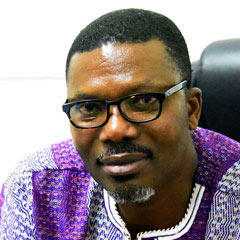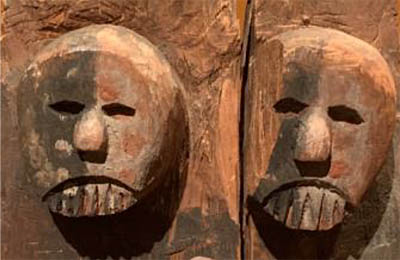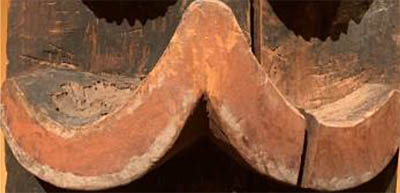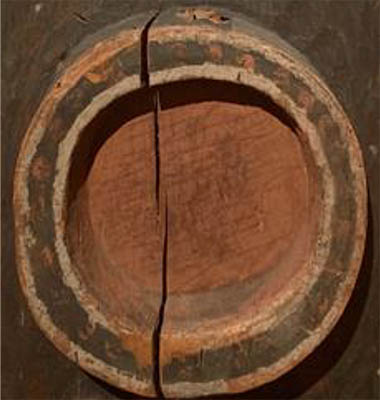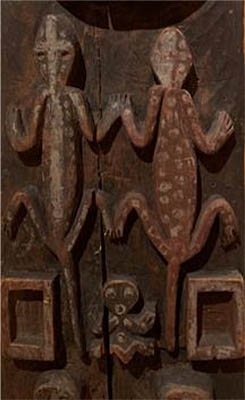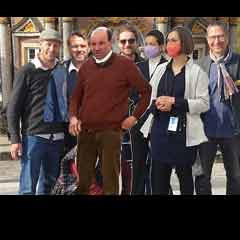This 'Veranda Post' is variously referred to (mostly in relation to its architectural-functional context) lintel or "te ken dy dye" (in the local Bandjoun language - PHSAA), porch post, house front pillar, post, cult house post (M5K, p. 17), Cameroon post / family crest (Macke at M5K, 13, 24). Post, however, in the sense of sign (post-it) is suggested by PdGY to address the communicative function. Other designations do not address the function, but limit themselves to the given, perhaps to avoid any pre-interpretation: 'sculpted wooden block' (Kecskési 1999 n. 108) or 'large carved square wooden block' (Kecskési 1976, p. 22).
Object biography: The object was taken before 1893 by Max von Stetten during expeditions on the Bamileke Plateau (south-western Cameroon), where it was presumably part of a meeting house of a confederation. Stetten (1860-1925) was German commander of the Kaiserliche Schutztruppe for Cameroon until 1896. Cameroon was a German colony at that time. The exact circumstances of how the object came into Stetten's possession are unknown, as is its original location and context.[2] In 1893, the Royal Ethnographic Collection acquired the pillar as a gift from Stetten.[3] In 1912, a photograph of the pillar was published in the Almanac of the Blaue Reiter. It is currently on display in the permanent exhibition in the Museum Fünf Kontinente Munich in a niche - a mirror allows a view of the second side (see Fig. 2). Along with other objects from the collection, it is currently the subject of a transnational project on their provenance (GI).
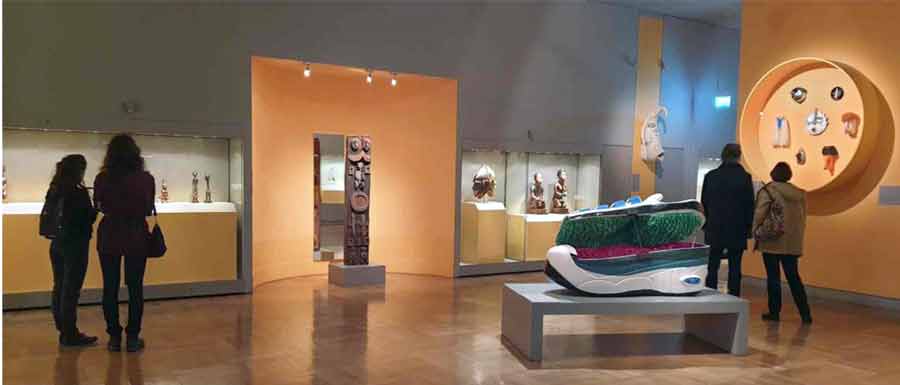
Fig. 2
Status: In comparison with carved mullions on façades of royal residences in the Cameroon grasslands (Fig. 3),[4] other mullions or door frames in the Museum Five Continents (M5K, p. 17, Kecskési 1999 No. 11, 70, 75) or in the Humboldt Forum Berlin, there is a partial similarity of motifs, but a strikingly 'archaic' formal language. Other examples are clearly more 'elaborate'. The multitude suggests that this type of pillar is quite typical of works from this period in this region of West Africa.
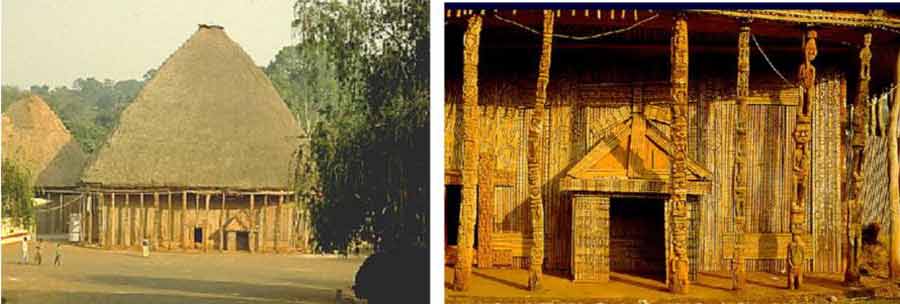
Fig. 3
Interpretation
The current view of the work
For the interpretation, the following questions lend themselves to art lessons: Form, iconography (meaning of the motifs), function, theme (or core idea) of the object, i.e. an interpretation.
With regard to the guiding idea of multi-perspectivity, two positions will be addressed: On the one hand, the view of today on the basis of ascertainable contexts, which seeks to understand the object from its time of origin and its context of origin. On the other hand, the view of the object by the artists of the Blaue Reiter. The comparison of these perspectives seems particularly relevant from an art didactic point of view, even though other perspectives would be conceivable, e.g. from the point of view of museology, provenance research, from the context of current restitution debates, etc. However, these are addressed in the teaching suggestions.
Shape
At first, the pillar develops an immediate physical presence for the visitor: through its sheer size (larger than life, almost square in plan), the materiality of the massive, cracked block of wood (the outline is irregular and probably corresponds to the tree) and the clear, concise, reduced language of form, whose meaning seems inaccessible. The surface treatment is archaic, the wood is more hewn than carved.[5] Thus it appears powerful and at the same time mysterious, which is supported by its presentation in the exhibition on a plinth and without glazing (see Fig. 4).
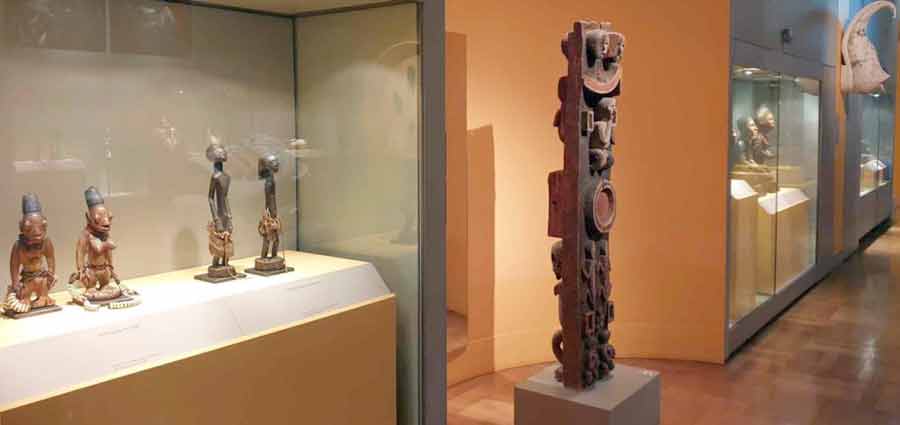
Fig. 4
A closer look reveals how the sculptor interweaves various modes of representation between complete abstraction (circle, rectangle) and representationalism (human figures, animals) in a compositional way[6] , monumentalising the individual motifs through internal symmetry, geometrisation, frontality and statics. This is supported by the painting (see Fig. 5). In this reduction, everything narrative is missing. The representation becomes emblematic, it becomes a symbol.
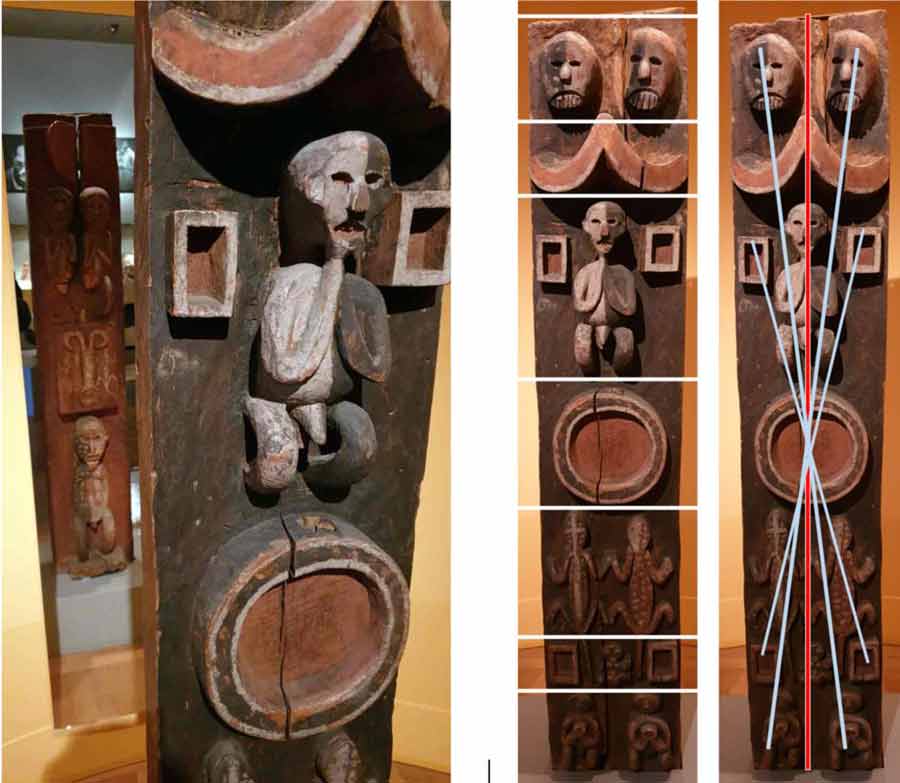
Fig. 5, 6 and 7
This is also supported by the overall composition, which obviously follows a calculated geometric order. It is strictly horizontally divided into individual zones, only once do lizard tails protrude into another zone. However, the separation into individual layers is ingeniously overcome compositionally by the strict axial symmetry in the vertical, but also by the point-symmetrical arrangement around the respective centres. The result is a tension between the contradictory compositional principles (see Figs. 6 and 7) that is decisive for the effect of the pillar.
The lack of any narrative on the one hand and the high creative effort on the other underline once again that it is about a symbolic level. This can perhaps be deciphered, even if its immediate complex order makes it seem above all direct, sensual.
The secure decoding of the iconography (what the individual motifs as well as the arrangement meant in the context of origin) is not possible with today's state of knowledge. Oral culture has left no written sources that could be consulted. Moreover, the oral tradition has been torn down - not least due to colonial destruction. However, since the work obviously has a symbolic language with clear iconography, this level cannot be left out in art lessons. German-language literature and oral experts from West Africa were consulted here. The results contradict each other, but nevertheless yield a court of meaning (see Fig. 8, in which the individual attributions of meaning are named)[7] , which provides a certain direction.
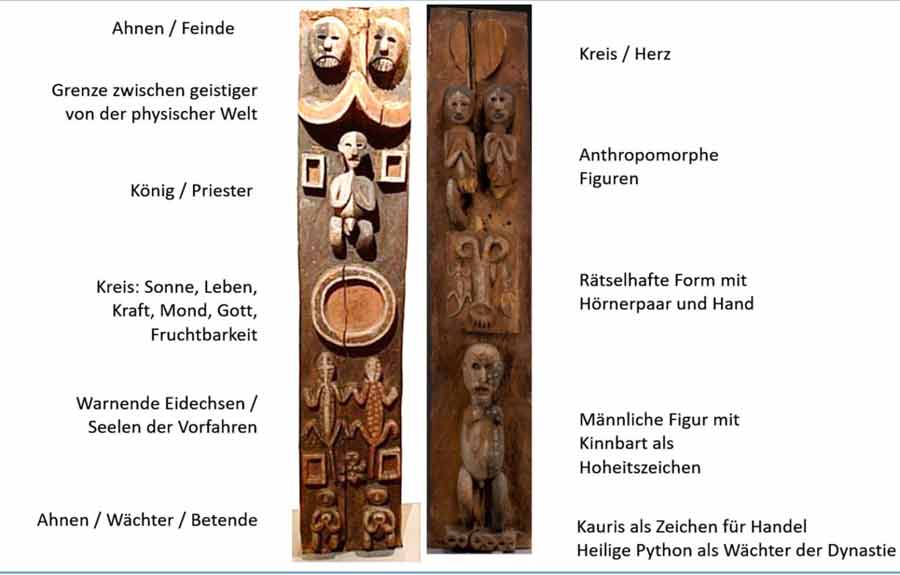
Fig. 8
In addition, the block is painted in three colours. These also carry meanings: Black could symbolise suffering, white could be the colour of the dead and symbolise mystery, red, the colour of blood, symbolises life (PHSAA). The light-dark contrasts themselves symbolise life and death (Kecskési 1999).
Function
PdGY suspects that the pillar - as part of the architecture of the house - stood at the spatial interface with the public (on a path) in order to communicate the significance of the house, presumably a cult house, to the outside. The object could therefore have been part of the façade of a particularly distinguished house[8] , also with a supporting function for the roof. It communicates what happens in the house or who lives or resides there.
Kecskési, on the other hand, considers a free positioning in space (Kecskési 1976, p. 22) and suspects an ancestral tablet. This in turn would fit the following determination by Gouaffo: "The 'Blue Rider Post' is a spiritual object. According to oral traditions, the object was placed in the sacred house like a statue. Caps, chains, bags or skeletons could hang from the object. Secret societies like the 'Losango' used the statue to perform certain rites, for example to cleanse the village of evil spirits." (Albert Gouaffo in GI) KG also suspects the context of a meeting house of such a secret society. Common to all assumptions is that the pillar stood in the context of a house with a sacred or cultic function.
'Theme' of the object: Basically, three different levels can be delimited, some complementary, some contradictory. First, the communication function on the façade or at the entrance to the outside. Then the pictorial formulation of a certain understanding of human being-in-the-world is asserted; man is ultimately embedded cosmologically.[9] At the Humboldtforum Berlin, in turn, such pillars from West Cameroon are also seen as the "architecture of power", power exercised by the rulers or the secret societies through impressing and deterring.[10]
Second perspective
The interpretation provided above can be countered by a second perception of the pillar, as it appears in the almanac "Der Blaue Reiter". This almanac, an artist's book, was published in 1912 by Franz Marc and Wassily Kandinsky. The reception of this book is over a hundred years old, but it is significant for the development of European art, as it is a good example of how artists of this time created a new frame of reference by referring to non-European art. In this respect, the Blaue Reiter clearly differs from Cubism, Expressionism or Dadaism, which were all being developed at the same time.
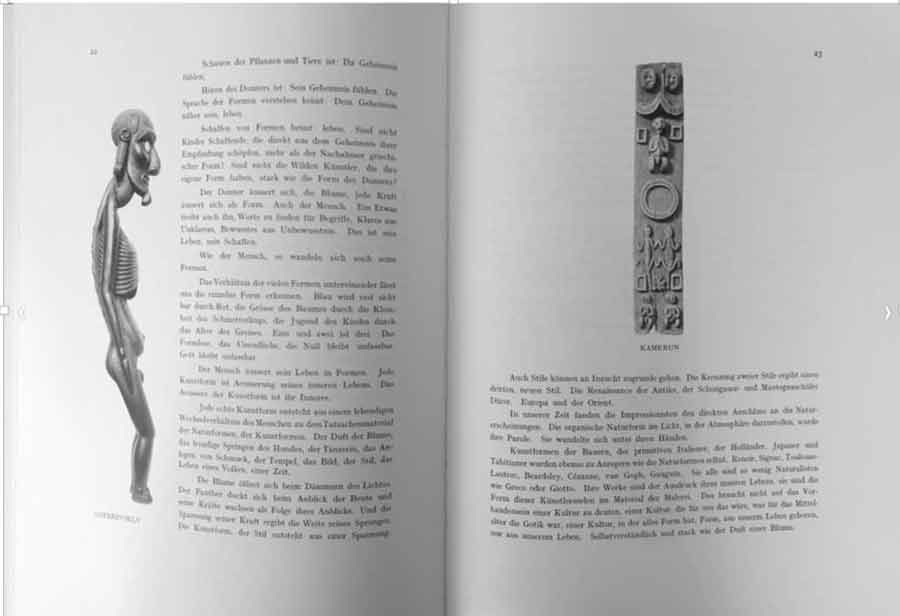
Fig. 9
In the Almanac, on pages 21 to 27, there is an essay by the painter August Macke entitled "Die Masken" (The Masks), in which a relatively small illustration of the pillar in question is embedded (see Fig. 9). Macke's contribution, like all the other texts in the Almanac, was probably written at a joint meeting of Macke, Marc, Münter and Kandinsky in Murnau.[11]
Visits to ethnographic museums are documented above all for Wassily Kandinsky, who was a trained ethnologist, and Franz Marc. Marc had also admired sculptures from Cameroon in particular during his visit to the Berlin Ethnographic Museum in 1911. And it was he who was ultimately responsible for the insertion of the photograph of the post in Macke's article.[12] In his letters to Macke, Marc writes about this. On 14.1.1911 about the objects from Cameroon in the Berlin Ethnological Museum: "I remained amazed and shaken by the carvings of the Cameroonians"; and later that he would furnish Macke's article in the Almanac with "ethnographic wonders" (MW).[13] In the text itself there is a single, very brief reference to "carved and painted pillars in a Negro hut", by which presumably the post was meant.
The text itself represents Macke's conception of art. In it, "intangible ideas", "mysterious forces", an "invisible God" express themselves in the world of appearances and "cultic expressions". The invisible materialises in the visible. This realm of the visible includes not only art, such as that of Giotto or van Gogh, who are classified as 'primitive', but also nature. Children's drawings, the folk art of the 'primitives' and 'savages' or non-European cultural forms are also expressions of the mysteriously invisible. These themselves are - and this is decisive - equal to each other. There is no hierarchy, no distinction between high and low, between high art and popular culture. All forms speak - as Macke characterises it - in "strong language". For Macke, the pillar in the museum is then an example of "the tangible form for an intangible idea, the personification of an abstract concept" (Macke 24). He also calls this the figure of an "idol".
The approach underlying this thinking sounds familiar; we have known it since the Platonic theory of ideas. However, this approach does not justify the selection of this particular post, as other posts from the museum's collection would also have been available.[14] Here one can only assume. I suspect that there are various factors that led to the selection: the archaic power of the forms; the initially wild and carefree-looking, additive combination (or montage) of the various principles of representation in the individual motifs (concrete - abstracted, geometric - organic, symbolising - depicting), which on closer inspection, however, then reveals itself to be consciously composed; or the coarse, physically perceptible materiality of the cracked, thick block of wood in impressive dimensions. PdGY also speaks of "wonderfully composed".
In the work, everything is represented with great sensual power that is the opposite of an "empty" image in European "cultures that have already passed through a thousand-year course, like [...] Italian Renaissance" (Macke 24) and from which Macke renounces: "We must bravely renounce almost everything that has hitherto been dear and indispensable to us as good Central Europeans [...] in order to get out of the fatigue of our European lack of taste". (Macke ibid.)
In art lessons, the question arises to what extent the image that Marc or Macke create of the pillar (as representative of the idea of an idol) goes together with what the object presumably was and is in its original context. Or to put it another way: are they designing a certain, exotic image that does not correspond to the object itself? [15]
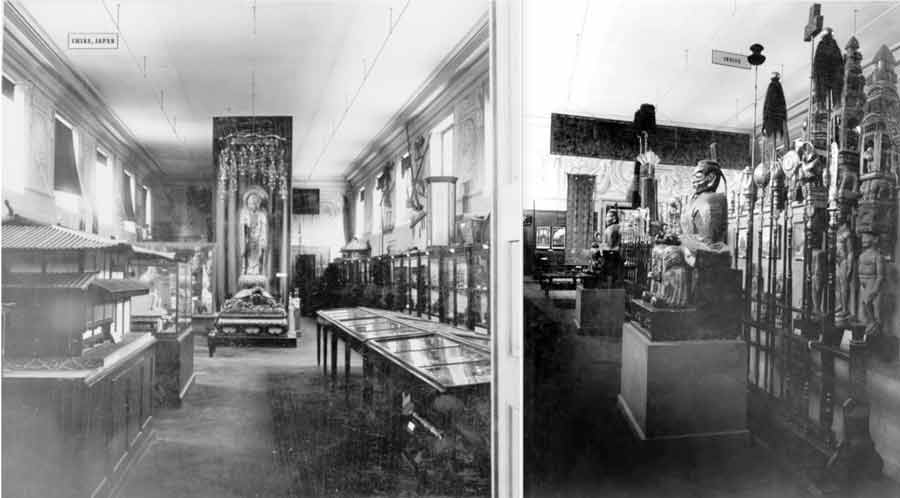
Fig. 10 Historical photos of the exhibition of the India Department in the Munich Museum around 1910 (source M5K)
References
- GI: Juliane Glahn and Marta Krus: CAMERUNS RIGHT TO CULTURAL OBJECTS. https://www.de/prj/zei/de/pos/22656808.html
- Kecskési 1999: Maria Kecskési. Art from Africa - Museum of Ethnology Munich. Munich (Prestel) 1999
- Kecskési 1976: Catalogue for the exhibition African Art. Andreas Lommel (ed.). Munich (Bruckmann) 1976
- M5K: Staatliches Museum für Völkerkunde München (ed.). The Blaue Reiter and the Munich Museum of Ethnology. Munich (Hirmer) 2009
- KG: Karin Guggeis. The Blue Rider Post. (2021): https://www.explore-vc.org/en/objects/expanding-the-canon-of-art-at-the-global-north.html
- PdGY: Patrique deGraft-Yankson. The Veranda Post. (2019) https://www.explore-vc.org/en/objects/the-veranda-post.html and oral interview on 23.4.2022 in Bayreuth, Iwalewahaus.
- PHSAA: Paul-Henri Souvenir Assako Assako. Information by email 20.5.2022
- Wikipedia: Cameroon & Max von Stetten
- MW: Macke Wolfgang (ed.). August Macke - Franz Marc: Briefwechsel, Texte und Perspektiven. 1964. Cologne (DuMont).
- Macke: Macke August. The Masks. In: Almanac "Der Blaue Reiter", 1912, edited by Franz Marc and Wassily Kandinsky, pp. 21-27
Appendix on iconography
- Anthropomorphic figures: ancestral couples / guardians and protectors of the royal residence. These anthropomorphic figures are treated with respect as extraordinary personalities. They are considered ensouled beings, spirits with supernatural powers. (PHSAA) Depiction of all human figures in similar postures: theme of prayer and submission to spirituality. (PdGY)
'Front' side from bottom to top:
- Two people: Ancestral couples / guardians and protectors of the royal residence (PHSAA). People pray for the guidance and protection of the ancestors (PdGY).
- Lizards: The symbol of the lizard warns everyone; it symbolises death. (PHSAA) PdGY sees here two crocodiles (ancestral souls returning to live with humans) instead of lizards.
- Circle: motif of the sun, symbol of life and power; the moon, image of woman and symbol of fertility. (PHSAA) The circle represents completeness, holiness, perfection and other attributes attributed to the supreme being (God). (PdGY)
- Kneeling figure: King or priest (PdGY)
- Line of demarcation between the spiritual and the physical world
- Two heads above: Ancestors (PdGY)
'Back' side from bottom to top:
- Python (geometric frieze at the bottom of the 'back' side): royal totem/sacred python, guardian of the dynasty (PHSAA).
- Male figure with chin beard as emblem of sovereignty (Kecskési 1999)
- Enigmatic form with a pair of horns ending in a hand (?) at the bottom (Kecskési) on a rectangle with two flanking lizards.
- Anthropomorphic figures
- Circular area
Footnotes
[1] The object is variously referred to, mostly in relation to its architectural-functional context: lintel or "te ken dy dye" (in the local Bandjoun language - PHSAA), porch post, house front pillar, post, cult house post (M5K, p. 17), Cameroon post / family crest (Macke at M5K, 13, 24). Post, however, in the sense of sign (post-it) is suggested by PdGY to address the communicative function. Other designations do not address the function, but limit themselves to the given, perhaps to avoid any pre-interpretation: 'sculpted wooden block' (Kecskési 1999 n. 108) or 'large carved square wooden block' (Kecskési 1976, p. 22).
[2] The first German trading posts were established in Cameroon as early as 1868, and in 1891 German military "expeditions" were launched in Cameroon. In 1884, the German Consul General concluded protection treaties with regional rulers and thus proclaimed the protectorate of Cameroon as a German colony. The seizure of the hinterland, which included the grasslands, took place over the course of the following 30 years. (Wikipedia) Even if the provenance is still not clear today, one can certainly share the Humboldt Forum's assessment of such objects that - even if they were not looted through acts of war - they are nevertheless "an expression of unequal power relations and structural, colonial violence". (https://www.smb.museum/nachrichten/detail/ethnologisches-museum-weg-frei-fuer-die-rueckkehr-der-ngonnso-nach-kamerun/)
[3] In the entry book it is noted: "Gr. square block, 1.80 cm high made of heavy wood, carved on both sides with humans and lizards, heavily damaged by termites". (https://onlinedatenbank-museum-fuenf-kontinente.de/) In 1895 Stetten published detailed "Travelogues" in the Deutsches Kolonialblatt.
[4] http://www1.biologie.uni-hamburg.de/b-online/afrika/kamerun/palast.htm; http://www1.biologie.uni-hamburg.de/b-online/afrika/
[5] The block is almost certainly worked with a chisel.
[6] "decorated with geometric, anthropomorphic and zoomorphic forms" (PHSAA)
[7] All performers avoid a complete decoding. They only make suggestions for individual motifs.
[8] It could have been the house of a 'priest' whom one could consult there and through whom or ancestors one could pray to God (PdGY).
[9] "Expression of the cosmogony of the universe of the peoples of the Bamileke plateau; expression of the belief system" (PHSAA).
[10] The assertion of power is also included by PHSAA.
[11] Catalogue: August Macke, Lenbachhaus Munich, 1987, Bruckmann. Munich. S.164
[12] He simply titled the painting "Cameroon", the name of the country of origin (the country whose sculptures he admired).
[13] There are other illustrations in the text: a bird's head from Brazil, a figure from Easter Island (see Fig. 9), one from Mexico, a bird mask from New Caledonia, a cloak from Alaska[13] and a child's drawing entitled "Arabs". Except for the child's drawing, all objects are from the then Royal Ethnographic Collection in Munich (M5K, p.11). They are only titled with the respective country of origin, e.g. Cameroon. Macke was obviously involved in the selection as well as the layout, as his layout sketch shows (M5K 24).
[14] It is not certain what was shown in the presentation at the Royal Ethnographic Collection in Munich at the time, which covered 400 square metres in six rooms in the north wing of the Hofgarten arcades in Munich. The only thing that is certain is that photos of the ten objects depicted, which came from various parts of the world, were lent to the artists for the publication of the Almanac. Photos of the presentation do not exist. "Whether Marc and Macke [actually also] saw the work in the exhibition at that time can be assumed with a high degree of probability, since it is after all very large and thus impressive." (Information Karin Guggeis 26.7.2022)
[15] In this context, it seems of interest that neither Marc nor Macke take up in their own pictorial language the aesthetics of the non-European works they "celebrate" here.

